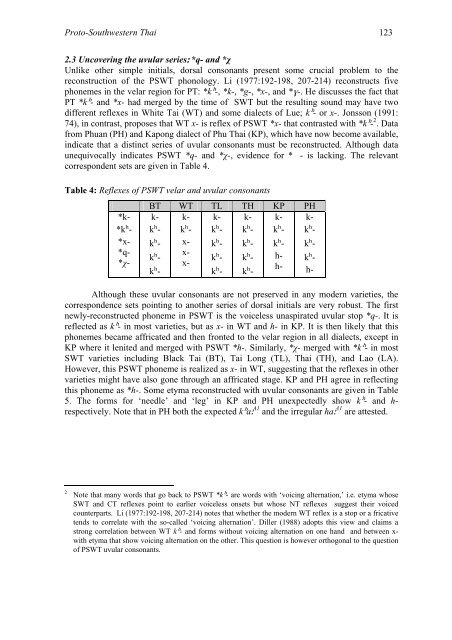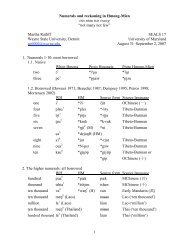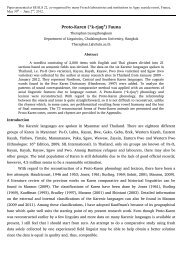proto-southwestern-tai revised: a new reconstruction - seals 22
proto-southwestern-tai revised: a new reconstruction - seals 22
proto-southwestern-tai revised: a new reconstruction - seals 22
Create successful ePaper yourself
Turn your PDF publications into a flip-book with our unique Google optimized e-Paper software.
Proto-Southwestern Thai 123<br />
2.3 Uncovering the uvular seriesː *q- and *χ<br />
Unlike other simple initials, dorsal consonants present some crucial problem to the<br />
<strong>reconstruction</strong> of the PSWT phonology. Li (1977:192-198, 207-214) reconstructs five<br />
phonemes in the velar region for PT: *kʰ-, *k-, *g-, *x-, and *ɣ-. He discusses the fact that<br />
PT *kʰ- and *x- had merged by the time of SWT but the resulting sound may have two<br />
different reflexes in White Tai (WT) and some dialects of Lue; kʰ- or x-. Jonsson (1991:<br />
74), in contrast, proposes that WT x- is reflex of PSWT *x- that contrasted with *kʰ- 2 . Data<br />
from Phuan (PH) and Kapong dialect of Phu Thai (KP), which have now become available,<br />
indicate that a distinct series of uvular consonants must be reconstructed. Although data<br />
unequivocally indicates PSWT *q- and *χ-, evidence for * - is lacking. The relevant<br />
correspondent sets are given in Table 4.<br />
Table 4: Reflexes of PSWT velar and uvular consonants<br />
*k-<br />
*kʰ-<br />
*x-<br />
*q-<br />
*χ-<br />
BT WT TL TH KP PH<br />
k-<br />
kʰkʰkʰkʰ-<br />
k-<br />
kʰ-<br />
x-<br />
x-<br />
x-<br />
k-<br />
kʰkʰkʰkʰ-<br />
k-<br />
kʰkʰkʰkʰ-<br />
k-<br />
kʰkʰh-<br />
h-<br />
k-<br />
kʰkʰkʰh-<br />
Although these uvular consonants are not preserved in any modern varieties, the<br />
correspondence sets pointing to another series of dorsal initials are very robust. The first<br />
<strong>new</strong>ly-reconstructed phoneme in PSWT is the voiceless unaspirated uvular stop *q-. It is<br />
reflected as kʰ- in most varieties, but as x- in WT and h- in KP. It is then likely that this<br />
phonemes became affricated and then fronted to the velar region in all dialects, except in<br />
KP where it lenited and merged with PSWT *h-. Similarly, *χ- merged with *kʰ- in most<br />
SWT varieties including Black Tai (BT), Tai Long (TL), Thai (TH), and Lao (LA).<br />
However, this PSWT phoneme is realized as x- in WT, suggesting that the reflexes in other<br />
varieties might have also gone through an affricated stage. KP and PH agree in reflecting<br />
this phoneme as *h-. Some etyma reconstructed with uvular consonants are given in Table<br />
5. The forms for ‘needle’ and ‘leg’ in KP and PH unexpectedly show kʰ- and h-<br />
respectively. Note that in PH both the expected kʰaː A1 and the irregular haː A1 are attested.<br />
2 Note that many words that go back to PSWT *kʰ- are words with ‘voicing alternation,’ i.e. etyma whose<br />
SWT and CT reflexes point to earlier voiceless onsets but whose NT reflexes suggest their voiced<br />
counterparts. Li (1977:192-198, 207-214) notes that whether the modern WT reflex is a stop or a fricative<br />
tends to correlate with the so-called ‘voicing alternation’. Diller (1988) adopts this view and claims a<br />
strong correlation between WT kʰ- and forms without voicing alternation on one hand and between x-<br />
with etyma that show voicing alternation on the other. This question is however orthogonal to the question<br />
of PSWT uvular consonants.





